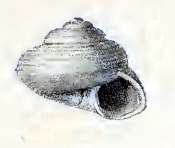Ethminolia glaphyrella
Ethminolia glaphyrella is a species of sea snail, a marine gastropod mollusk in the family Trochidae, the top snails.[1][2]
| Ethminolia glaphyrella | |
|---|---|
 | |
| Original image of a shell of Ethminolia glaphyrella | |
| Scientific classification | |
| Kingdom: | Animalia |
| Phylum: | Mollusca |
| Class: | Gastropoda |
| Clade: | Vetigastropoda |
| Order: | Trochida |
| Superfamily: | Trochoidea |
| Family: | Trochidae |
| Genus: | Ethminolia |
| Species: | E. glaphyrella |
| Binomial name | |
| Ethminolia glaphyrella (Melvill & Standen, 1895) | |
| Synonyms[1] | |
| |
Description
The size of the rotund-conoidal shell attains 6 mm. A neat little, rather solid species, with a very pale straw colour. The apex is obtuse. The shell contains five, ventricose whorls. The sutures are impressed. The shell is uniformly delicately transversely lirate. Under a lens some very obscure small brown spotted markings on the lirae, and larger spots at the periphery, are observable. The body whorl is subangulate at the periphery and has dark brown spots. The shell has a deep but narrow umbilicus The small aperture is roundish. The outer lip is barely swollen. The margin of the columella is a little contracted.[3]
Distribution
This marine species occurs off the Loyalty Islands.
References
- Bouchet, P. (2012). Ethminolia glaphyrella (Melvill & Standen, 1895). Accessed through: World Register of Marine Species at http://www.marinespecies.org/aphia.php?p=taxdetails&id=567514 on 2012-11-23
- Raines, B.K. (2007) New molluscan records from Easter Island, with the description of a new Ethminolia. Visaya, 2(1), 70-88.
- Melvill & Standen (1895), Catalogue of the Hadfield collection of shells from the Lifu and Uvea, Loyalty Islands; Manchester Museum (University of Manchester)
External links
- To World Register of Marine Species
- "Conotalopia glaphyrella". Gastropods.com. Retrieved 16 January 2019.